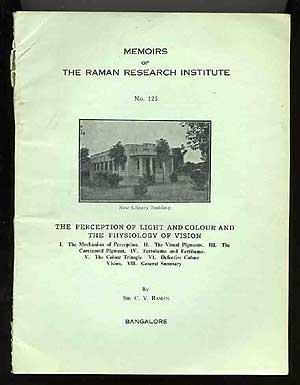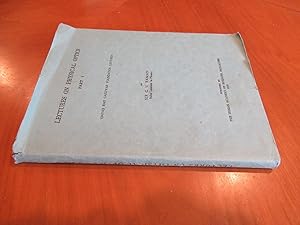Raman,sir C V (2 results)
Product Type
- All Product Types
- Books (2)
- Magazines & Periodicals
- Comics
- Sheet Music
- Art, Prints & Posters
- Photographs
- Maps
-
Manuscripts &
Paper Collectibles
Condition
- All Conditions
- New
- Used
Binding
Collectible Attributes
- First Edition (1)
- Signed
- Dust Jacket (1)
- Seller-Supplied Images
- Not Printed On Demand
Seller Location
Seller Rating
-
Memoirs of The Raman Research Institute
Published by Bangalore, MD, 1960
Seller: Between the Covers-Rare Books, Inc. ABAA, Gloucester City, NJ, U.S.A.
Softcover. Condition: Very Good. Very good paperback. The book spine has a few tears. The book covers are lightly soiling. The text is nice and clean.
-
Lectures On Physical Optics, Part I (Sayaji Rao Gaekwar Foundation Lectures)
Published by The Indian Academy Of Sciences, Bangalore, 1959
Seller: Arroyo Seco Books, Pasadena, Member IOBA, Pasadena, CA, U.S.A.
Association Member: IOBA
Book First Edition
Hardcover. Condition: Fine. Dust Jacket Condition: Very Good. 1st Edition. 160 Pp. Brown Cloth Printed In Black. First Printing. Near Fine, Very Slight Rubbing At Corners, Some Slight Browning To Endpapers; In Lightly Worn Blue Dj With Very Short Tears And Minor Losses Along Top And Bottom Edges Of Spine. No Names Or Marks. Chandrasekhara Venkata Raman Frs (1888 ?1970) Was An Indian Physicist Known For His Work In The Field Of Light Scattering. Using A Spectrograph That He Developed, He And His Student K. S. Krishnan Discovered That When Light Traverses A Transparent Material, The Deflected Light Changes Its Wavelength And Frequency. This Phenomenon, A Hitherto Unknown Type Of Scattering Of Light, Which They Called "Modified Scattering" Was Subsequently Termed The Raman Effect Or Raman Scattering. In Addition To Being A New Phenomenon Itself, The Raman Effect Was One Of The Earliest Proofs Of The Quantum Nature Of Light. Robert W. Wood At The Johns Hopkins University Was The First American To Confirm The Raman Effect In The Early 1929. He Made A Series Of Experimental Verification, After Which He Commented, Saying, "It Appears To Me That This Very Beautiful Discovery Which Resulted From Raman's Long And Patient Study Of The Phenomenon Of Light Scattering Is One Of The Most Convincing Proofs Of The Quantum Theory". The Field Of Raman Spectroscopy Came To Be Based On This Phenomenon, And Ernest Rutherford, President Of The Royal Society, Referred To It In His Presentation Of The Hughes Medal To Raman In 1930 As "Among The Best Three Or Four Discoveries In Experimental Physics In The Last Decade".Raman Received The 1930 Nobel Prize In Physics For The Discovery And Was The First Asian To Receive A Nobel Prize In Any Branch Of Science. With Suri Bhagavantam, He Determined The Spin Of Photons In 1932, Which Further Confirmed The Quantum Nature Of Light. With Another Student, Nagendra Nath, He Provided The Correct Theoretical Explanation For The Acousto-Optic Effect (Light Scattering By Sound Waves) In A Series Of Articles Resulting In The Celebrated Raman?Nath Theory. Modulators, And Switching Systems Based On This Effect Have Enabled Optical Communication Components Based On Laser Systems. Other Investigations He Carried Out Included Experimental And Theoretical Studies On The Diffraction Of Light By Acoustic Waves Of Ultrasonic And Hypersonic Frequencies, And Those On The Effects Produced By X-Rays On Infrared Vibrations In Crystals Exposed To Ordinary Light Which Were Published Between 1935 And 1942. In 1948, Through Studying The Spectroscopic Behaviour Of Crystals, He Approached The Fundamental Problems Of Crystal Dynamics In A New Manner.[104][105] He Dealt With The Structure And Properties Of Diamond From 1944 To 1968,[ The Structure And Optical Behaviour Of Numerous Iridescent Substances Including Labradorite, Pearly Feldspar, Agate, Quartz, Opal, And Pearl In The Early 1950S. Among His Other Interests Were The Optics Of Colloids, And Electrical And Magnetic Anisotropy His Last Interests In The 1960S Were On Biological Properties Such As The Colours Of Flowers And The Physiology Of Human Vision.Raman Was The Paternal Uncle Of Subrahmanyan Chandrasekhar, Recipient Of The 1983 Nobel Prize In Physics.



